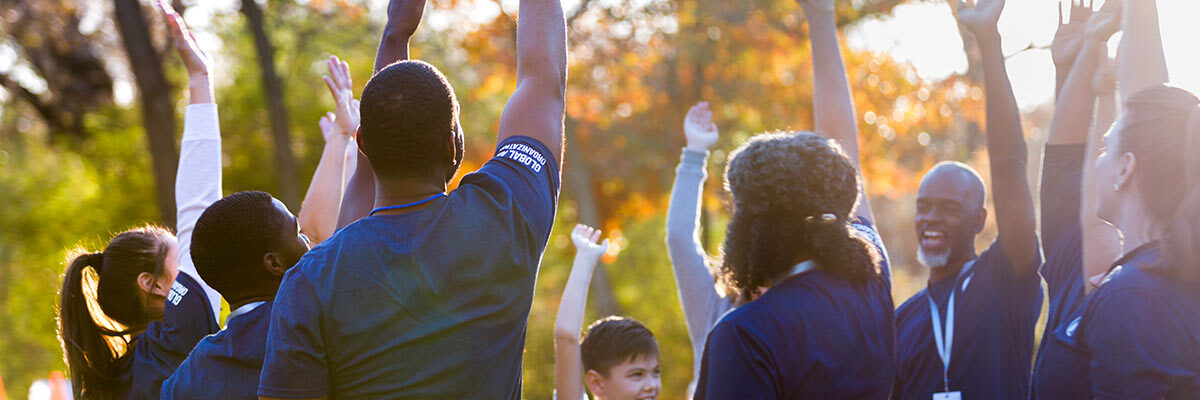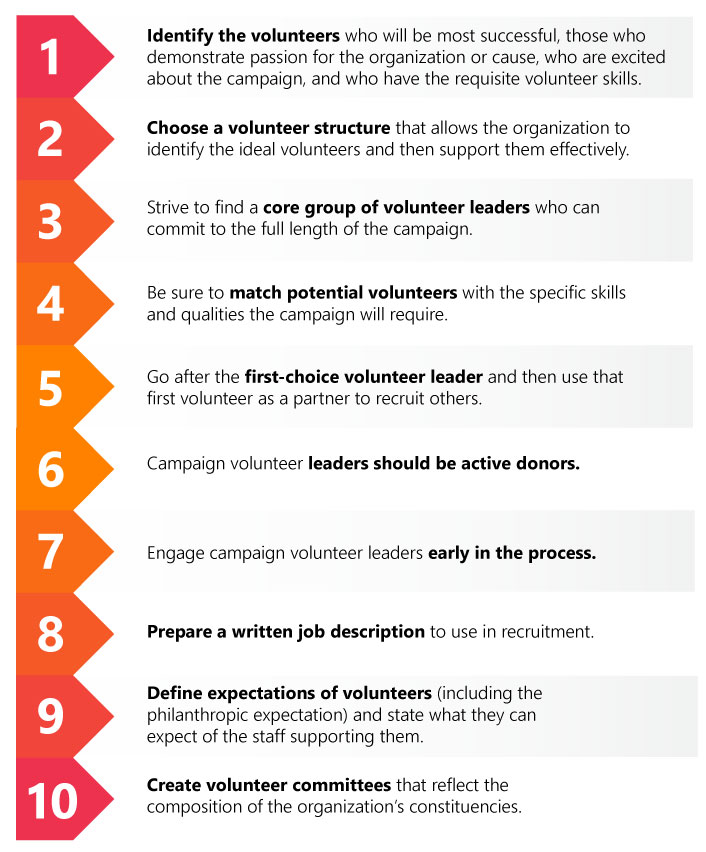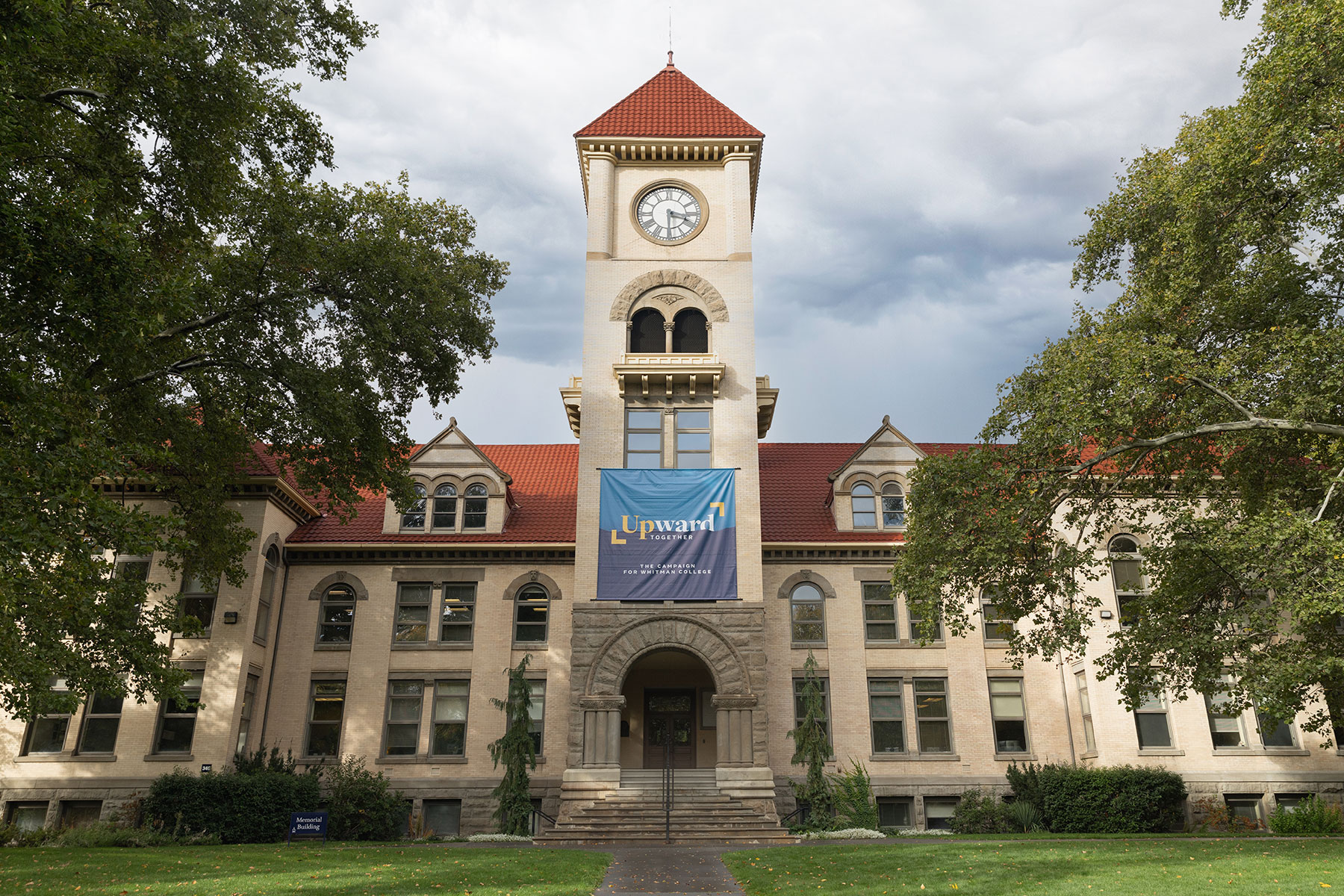Modern fundraising campaigns—which are more complex, have bigger goals, and last longer than before—can be a juggernaut for even the most sophisticated fundraising shop.
Campaign volunteers are essential today and are often a key factor to success. The right volunteers can tap into their networks and use their passion to influence others to make philanthropic investments. Organizations that can attract the right volunteer leaders to help guide and drive a campaign forward add another critical factor to their campaign strategy. The right volunteers are those who themselves are able and willing to make major gifts and can inspire others to do the same. They have a demonstrated affinity for the mission and come with talents and relationships that are invaluable to a campaign. Selecting and engaging these campaign volunteers must be an intentional effort, one requiring strategy, commitment, and an understanding that the long view reaps the best rewards.
Getting the Right Volunteer Leaders Onboard
Following are the strategies and best practices BWF recommends for effectively engaging volunteer leaders in a campaign.
#1 Identification
The first step is to identify the volunteers who will be most successful. Look for individuals who demonstrate passion for the organization or cause, who are excited about the effect a successful campaign can have on the organization’s ability to fulfill its mission, and who have the requisite volunteer skills. These qualities will help ensure that the volunteers exhibit a strong sense of campaign ownership and will talk about the campaign as “our campaign.” And aligning a given volunteer’s interests with campaign priorities will make that volunteer stronger and more successful when making appeals.
When identifying individuals to hold volunteer roles, strive to find a core group of volunteer leaders who can commit to the full length of the campaign. The requirements on their time will ebb and flow throughout the campaign, but the continuity provides prospects with a consistent message.
As campaigns get longer and the tenures of chief executives get shorter, the likelihood of leadership transitions during campaigns increases. Consistent volunteer leadership can counteract staff transitions and add significant stability, and so it’s ideal to have a core group of volunteer leaders committed to the campaign’s full duration. But, depending on the size and scope of the campaign, it might be prudent to have specific leaders and committees for the leadership, major gift, and public phases of the campaign.
Be sure to match potential volunteers with the specific skills and qualities the campaign will require. For example, early campaign phases require volunteers who can be good peer screeners, are willing to host campaign awareness events, and share their personal stories to inspire others. For those comfortable with more direct fundraising, they can provide access to their personal networks and partner with the chief executive or chief development officer in soliciting top prospects.
#2 Recruitment
Once top candidates have been identified, it’s time to begin recruitment. First, go after the ideal candidate for the volunteer leader. This may be an perfect time to call upon the chief executive to do the outreach. After successfully getting a “Yes,” use that first volunteer as a partner to recruit others. After all, people have a difficult time saying no to community and organization leaders.
Recruitment timing is almost as important as its execution. Campaigns are the result of months or even years of strategic planning. Engaging volunteers early in the process allows them to take part in the strategic planning effort, which provides them with a sense of ownership in the vision for the campaign and in specific projects.
Campaign volunteer leaders should be active donors, and their feedback can be incredibly meaningful in helping the campaign appeal to other prospects. However, there is a fine line between bringing in volunteers early enough to develop a sense of ownership and getting them engaged so early that keeping their energy and engagement levels high becomes an issue. To avoid having valuable volunteers burn out and back away, think about the recruitment process in a tiered approach. Instead of recruiting all at once, bring in some volunteers earlier and others later in order to maximize continuity and sustain energy.
#3 Definition of Roles and Responsibilities
Recruiting volunteer leaders without clear expectations and a written job description can have negative consequences. If volunteers are scared away from taking on the responsibilities laid out during the recruitment process, one of two issues may be at hand:
- The expectations are too high.
- The wrong individuals are being targeted.
It is critically important to define exactly what the expectations are of volunteers and what their expectations should be of the staff to support them in the campaign. Providing documentation of these roles early on prevents surprises from arising down the road, losing volunteers, or causing turnover due to unclear or unrealistic expectations.
And don’t neglect to clearly state the philanthropic expectations of volunteers during recruitment. Expectations about the amount or purpose of a gift should be a natural part of any recruitment process.
#4 Onboarding
Volunteer leaders must be equipped with the knowledge they need to effectively execute their duties. Depending on the scope of their involvement, training might be a 15-minute session before they assume the role or it may involve a multi-week orientation conducted by staff and/or campaign counsel. It is important to view orientation as a series of varied experiences as opposed to a single moment in time. Many of the most successful organizations create ongoing opportunities for the development of their volunteers through the use of pairing new and existing volunteers as mentors and having routine check-ins with members of the staff to ensure that the experience is positive for the volunteer … and the organization.
#5 Communication
To ensure volunteers are ready to play their vital role in a campaign, they need information and ongoing communication. Upfront, they need talking points, the case for support, unit or pillar cases, and even early access to the campaign website to ensure they have the messaging to describe the vision for the campaign, the pillars and fundraising opportunities, and the expected impact that will result from successful fundraising. Keep them in the loop by sending updates between meetings or the special events they will be invited to and ensure that the person managing them is interacting with each volunteer through their preferred channels. In addition, encourage volunteers to keep practicing their elevator pitch so it’s honed prior to any engagement with prospective donors.
#6 Recognition
We often think about donor recognition but forget the value of volunteer recognition. Recognition is a key step in developing and retaining successful volunteer leaders. Volunteers need to feel they are being celebrated for the campaign impact they are having. Not celebrating successes risks losing volunteers due to lack of appreciation. Communicating appreciation regularly to volunteers can play an important role in this recognition. Recognition also creates opportunities to inspire the next generation of volunteer leadership by demonstrating to as-yet-unaffiliated prospective volunteers that the organization cares deeply for its volunteers and is demonstrably appreciative of their efforts.
#7 Support
A solid support structure is vital to successful volunteer engagement. Staff and resources must be dedicated to supporting the work of the volunteers. One or more staff members should be their go-to person—the one managing their activities and helping keep the momentum going. Financial resources should be budgeted for their work, and any technological needs or access should be provided. Campaign volunteer leaders are always more successful and more satisfied with their experience when supported in their efforts.
Top 10 Tips for Recruiting and Engaging the Right Campaign Volunteer Leaders
5 Ways to Structure Volunteers
After identifying and recruiting the best possible individuals and providing them with clear expectations, the next step is to structure and manage these volunteers.
Co-chairs are at the top of the structure. Typically, having co-chairs is preferable to a single chair. Co-chairs allow for greater overlap of constituents (for example, by age, gender, geographic location, project interest) and a sharing of the workload to ease the burden that any one individual may feel. If a transition among the chairs is expected during the campaign, then it is advisable to have one pair lead the campaign through the leadership phase and into the first year of the public phase prior to transitioning to the other pair.
The co-chairs can lead a steering committee (or whatever you choose to name the lead group). There are several options for how these groups can be structured:
- One model is a national campaign committee comprised of trustees, development board members, and potentially other community members outside of these two bodies or representatives of important constituencies.
- If the institution or organization has constituents across the country or globe, then regional representatives are important too. For organizations with more local or regional reach, those committees should reflect the composition of the organization’s constituencies.
- Another model often used by higher education institutions is organized around constituent types, such as alumni, parents, and grandparents. These can take the place of the regional approach and allow for volunteers to connect with others who see themselves as connected because of having similar ties to the institution.
- A different model organizes leadership around campaign priorities, where volunteers focus their efforts on securing support for specific projects, such as a new facility, endowed positions, or a particular program.
- If the organization is engaged in Community-Centric Fundraising, a fundraising model grounded in equity and social justice, then community-based committee members should include those with a vested interest in such work.
Regardless of which model is used, it is important that the structure allows the organization to identify the ideal volunteers and then support them effectively. Providing them with a high-quality engagement experience as they help drive the campaign forward and solicit their peers will reap rewards beyond fundraising totals.
Volunteer Leaders are Key to Success
For fundraising teams today to reach—and exceed—campaign goals, myriad elements must come together, and that includes campaign volunteer leaders. Recruiting the right people to take on important leadership roles in the campaign and to serve as campaign champions and ambassadors can be a key ingredient in achieving campaign success.





